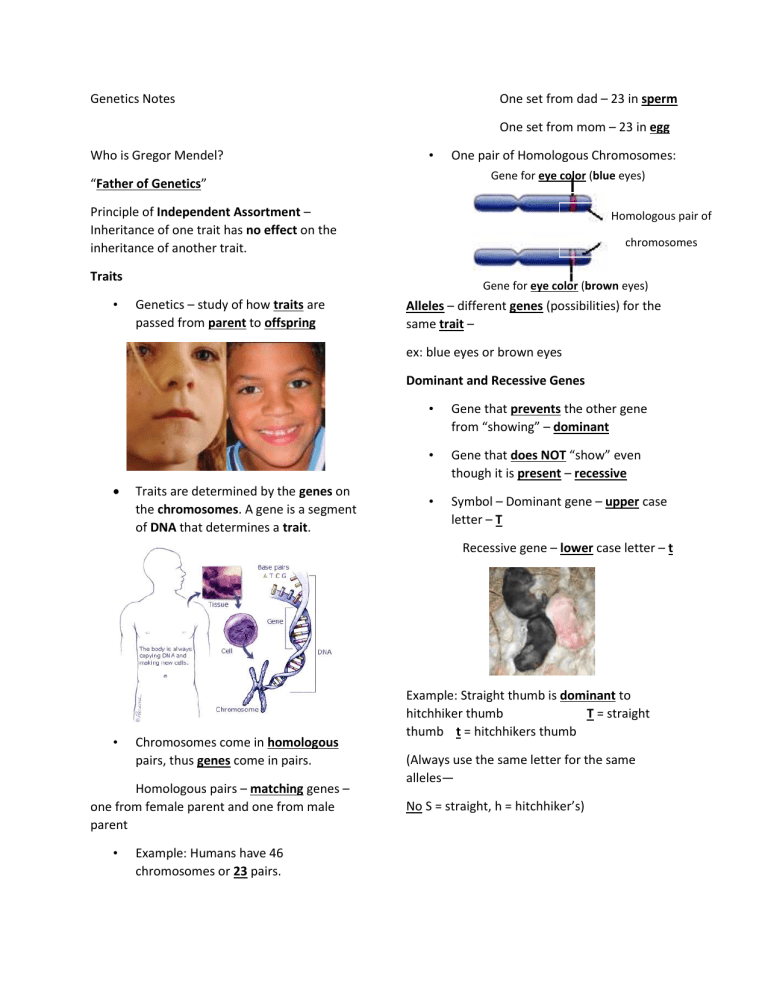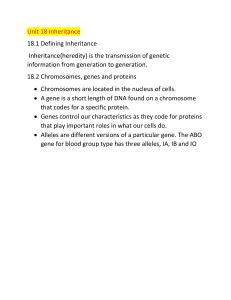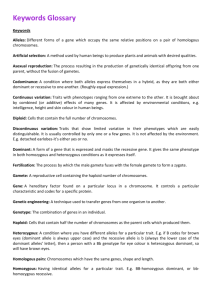
Genetics Notes One set from dad – 23 in sperm One set from mom – 23 in egg Who is Gregor Mendel? • One pair of Homologous Chromosomes: Gene for eye color (blue eyes) “Father of Genetics” Principle of Independent Assortment – Inheritance of one trait has no effect on the inheritance of another trait. Homologous pair of chromosomes Traits • Gene for eye color (brown eyes) Genetics – study of how traits are passed from parent to offspring Alleles – different genes (possibilities) for the same trait – ex: blue eyes or brown eyes Dominant and Recessive Genes Traits are determined by the genes on the chromosomes. A gene is a segment of DNA that determines a trait. • Gene that prevents the other gene from “showing” – dominant • Gene that does NOT “show” even though it is present – recessive • Symbol – Dominant gene – upper case letter – T Recessive gene – lower case letter – t • Chromosomes come in homologous pairs, thus genes come in pairs. Homologous pairs – matching genes – one from female parent and one from male parent • Example: Humans have 46 chromosomes or 23 pairs. Example: Straight thumb is dominant to hitchhiker thumb T = straight thumb t = hitchhikers thumb (Always use the same letter for the same alleles— No S = straight, h = hitchhiker’s) Ex: hitchhiker’s thumb or straight thumb Straight thumb = TT Punnett Square and Probability Straight thumb = Tt Hitchhikers thumb = tt • * Must have 2 recessive alleles for a recessive trait to “show” Used to predict the possible gene makeup of offspring – Punnett Square • Example: Black fur (B) is dominant to white fur (b) in mice • Both genes of a pair are the same – homozygous or purebred TT – homozygous dominant tt – homozygous recessive • One dominant and one recessive gene – heterozygous or hybrid Tt – heterozygous BB – Black bb – White Bb – Black w/ white gene Genotype and Phenotype • Combination of genes an organism has (actual gene makeup) – genotype Ex: TT, Tt, tt • Physical appearance resulting from gene make-up – phenotype 1. Cross a heterozygous male with a homozygous recessive female. Sex Determination • People – 46 chromosomes or 23 pairs • 22 pairs are homologous (look alike) – called autosomes – determine body traits 1 pair is the sex chromosomes – determines sex (male or female) • Females – sex chromosomes are homologous (look alike) – label XX Males – sex chromosomes are different – label XY Incomplete dominance and Codominance • When one allele is NOT completely dominant over another (they blend) – incomplete dominance Example: In carnations the color red (R) is incompletely dominant over white (W). The hybrid color is • 2. hemophilia – blood won’t clot • Example: A female that has normal vision but is a carrier for colorblindness marries a male with normal vision. Give the expected phenotypes of their children. pink. Give the genotypic and phenotypic ratio from a cross between 2 pink flowers. RW X RW N = normal vision RR RW n = colorblindness XN Xn X XN Y RW Genotypic = WW 1 RR : 2 RW : 1 WW Phenotypic = 1 red : 2 pink : 1 white • When both alleles are expressed – Codominance Example: In certain chickens black feathers are codominant with white feathers. Heterozygous chickens have black and white speckled feathers. • Graphic representation of how a trait is passed from parents to offspring Genes for these traits are located only on the X chromosome (NOT on the Y chromosome) • Tips for making a pedigree X linked alleles always show up in males whether dominant or recessive because males have only one X chromosome 2. Squares are for males Sex – linked Traits • • Pedigrees • Examples of recessive sex-linked disorders: • colorblindness – inability to distinguish between certain colors • Color blindness is the inability to distinguish the differences between certain colors. The most common type is red-green color blindness, where red and green are seen as the same color. 1. Circles are for females 3. Horizontal lines connecting a male and a female represent a marriage 4. Vertical line and brackets connect parent to offspring 5. A shaded circle or square indicates a person has the trait 6. A circle or square NOT shaded represents an individual who does NOT have the trait 7. Partial shade indicates a carrier – someone who is heterozygous for the trait Mutations • Mutation – sudden genetic change (change in base pair sequence of DNA) • Can be : Harmful mutations – organism less able to survive: genetic disorders, cancer, death Beneficial mutations – allows organism to better survive: provides genetic variation Neutral mutations – neither harmful nor helpful to organism • Mutations can occur in 2 ways: chromosomal mutation or gene/point mutation Chromosomal mutation: • less common than a gene mutation • more drastic – affects entire chromosome, so affects many genes rather than just one • caused by failure of the homologous chromosomes to separate normally during meiosis • chromosome pairs no longer look the same – too few or too many genes, different shape Tay-Sachs Disease – deterioration of the nervous system – early death • Mutated genes produce enzymes that are less effective than normal at breaking down fatty cell products known as gangliosides. As a result, gangliosides build up in the lysosomes and overload cells. Their buildup ultimately causes damage to nerve cells. Phenylketonuria (PKU) – an amino acid common in milk cannot be broken down and as it builds up it causes mental retardation – newborns are tested for this Examples: Down’s syndrome – (Trisomy 21) 47 chromosomes, extra chromosome at pair #21 Turner’s syndrome – only 45 chromosomes, missing a sex chromosome (X) Girls affected – short, slow growth, heart problems Klinefelter’s syndrome – 47 chromosomes, extra X chromosomes (XXY) Boys affected – low testosterone levels, underdeveloped muscles, sparse facial hair • Having an extra set of chromosomes is fatal in animals, but in plants it makes them larger and hardier. Dominant gene mutations: Huntington’s disease – gradual deterioration of brain tissue, shows up in middle age and is fatal Dwarfism – variety of skeletal abnormalities Detecting Genetic Disorders • picture of an individual’s chromosomes – karyotype • amniotic fluid surrounding the embryo is removed for analysis – amniocentesis • Female with Down’s syndrome Gene or Point Mutation • most common and least drastic • only one gene is altered • Examples: Recessive gene mutations: Sickle cell anemia – red blood cells are sickle shaped instead of round and cannot carry enough oxygen to the body tissues – heterozygous condition protects people from malaria Cystic fibrosis – mucous builds up in the lungs




